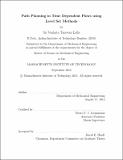Path planning in time dependent flows using level set methods
Author(s)
Lolla, Sri Venkata Tapovan
DownloadFull printable version (14.82Mb)
Other Contributors
Massachusetts Institute of Technology. Dept. of Mechanical Engineering.
Advisor
F. J. Lermusiaux.
Terms of use
Metadata
Show full item recordAbstract
Autonomous underwater vehicles such as gliders have emerged as valuable scientific platforms due to their increasing uses in several oceanic applications, ranging from security, acoustic surveillance and military reconnaissance to collection of ocean data at specific locations for ocean prediction, monitoring and dynamics investigation. Gliders exhibit high levels of autonomy and are ideal for long range missions. As these gliders become more reliable and affordable, multi-vehicle coordination and sampling missions are expected to become very common in the near future. This endurance of gliders however, comes at an expense of being susceptible to typical coastal ocean currents. Due to the physical limitations of underwater vehicles and the highly dynamic nature of the coastal ocean, path planning to generate safe and fast vehicle trajectories becomes crucial for their successful operation. As a result, our motivation in this thesis is to develop a computationally efficient and rigorous methodology that can predict the time-optimal paths of underwater vehicles navigating in continuous, strong and dynamic ow-fields. The goal is to predict a sequence of steering directions so that vehicles can best utilize or avoid ow currents to minimize their travel time. In this thesis, we fist review existing path planning methods and discuss their advantages and drawbacks. Then, we discuss the theory of level set methods and their utility in solving front tracking problems. Then, we present a rigorous (partial differential equation based) methodology based on the level set method, which can compute time-optimal paths of swarms of underwater vehicles, obviating the need for any heuristic control based approaches. We state and prove a theorem, along with several corollaries, that forms the foundation of our approach for path planning. We show that our algorithm is computationally efficient - the computational cost grows linearly with the number of vehicles and geometrically with spatial directions. We illustrate the working and capabilities of our path planning algorithm by means of a number of applications. First, we validate our approach through simple benchmark applications, and later apply our methodology to more complex, realistic and numerically simulated ow-fields, which include eddies, jets, obstacles and forbidden regions. Finally, we extend our methodology to solve problems of coordinated motion of multiple vehicles in strong dynamic ow-fields. Here, coordination refers to maintenance of specific geometric patterns by the vehicles. The level-set based control scheme that we derive is shown to provide substantial advantages to a local control approach. Specifically, the illustrations show that the resulting coordinated vehicle motions can maintain specific patterns in dynamic flow fields with strong and complex spatial gradients.
Description
Thesis (S.M.)--Massachusetts Institute of Technology, Dept. of Mechanical Engineering, 2012. This electronic version was submitted by the student author. The certified thesis is available in the Institute Archives and Special Collections. Cataloged from student-submitted PDF version of thesis. Includes bibliographical references (p. 167-177).
Date issued
2012Department
Massachusetts Institute of Technology. Department of Mechanical EngineeringPublisher
Massachusetts Institute of Technology
Keywords
Mechanical Engineering.